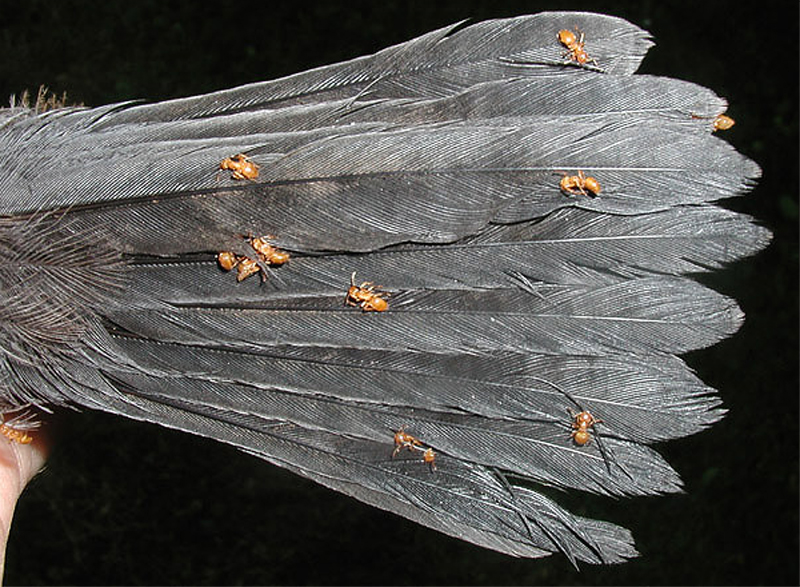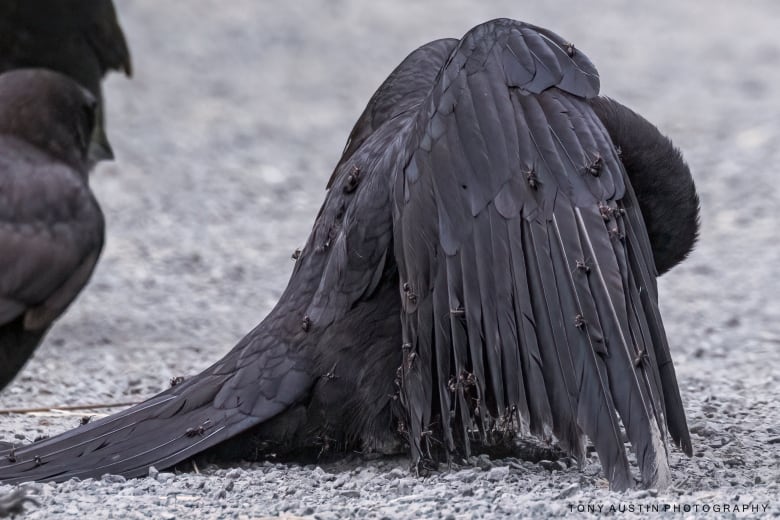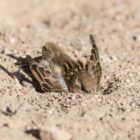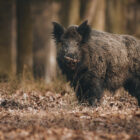Why do birds put ants in their feathers?

The behavior of anting in birds has been observed in a wide range of bird species, from small songbirds to large raptors. But what drives birds to engage in this behavior? Is there a scientific explanation behind it?
The Ritual of Anting
Anting, a fascinating behavior observed in various bird species, is a process where birds rub or place ants and other arthropods on their feathers. This ritual has long puzzled ornithologists and naturalists, with several theories proposed to explain this behavior.
Anting typically involves a bird picking up ants, either by actively seeking them out or by encountering them while foraging, and then rubbing or allowing the ants to crawl over their feathers. Sometimes, the birds will lie on the ground, wings spread, and allow the ants to crawl over their bodies. This behavior can last anywhere from a few seconds to several minutes.
The Evidence for Anting
The earliest documented accounts of anting behavior in birds can be traced back to the early 19th century. In 1831, American ornithologist John James Audubon made an observation regarding wild juvenile turkeys that seemed to be “wallowing” in abandoned ant hills. This intriguing behavior was further documented in 1847 by a naturalist who penned a manuscript titled “Bird of Jamaica“. In this manuscript, the author recounted an incident where ants were observed removing parasites from a tame crow while it was foraging for food.
The phenomenon gained more attention in 1934 when Alexander Hugh Chisholm highlighted a peculiar relationship between birds and ants in his work “Bird Wonders of Australia”. The behavior was more formally described by Erwin Stresemann in German as “Einemsen” in the German ornithology journal Ornithologische Monatsberichte in 1935.
It was not until 1936 that Indian ornithologist Salim Ali interpreted an observation made by his cousin Humayun Abdulali in the Journal of the Bombay Natural History Society. He also referenced Stresemann’s paper, suggesting that the German term “Einemsen” could be translated into English as “anting.”
One of the earliest scientific pieces of evidence for anting comes from the pioneering work of Alexander Skutch, a renowned ornithologist who conducted extensive field studies on birds in Central and South America. Skutch observed that birds, particularly thrushes and other songbirds, would often sit on ant nests and allow the ants to crawl over their feathers. He also noted that birds would sometimes pick up ants in their beaks and rub them on their feathers, a behavior known as active anting.

The Role of Formic Acid
One of the most compelling explanations for anting in birds is the role of formic acid, a compound found in the bodies of many ant species.
Formic acid, also known as methanoic acid, is a colorless, pungent-smelling liquid that is miscible with water and has a boiling point of 100.8 °C. It is naturally produced by ants as a defensive mechanism, acting as a deterrent against predators. When ants feel threatened, they can release formic acid from their mandibular glands, causing a burning sensation and irritation to the skin of their attackers. This defensive behavior is particularly common among species of ants in the Formicidae family, such as the red ants (Myrmicinae).
When birds engage in anting, they are essentially exposing themselves to formic acid. However, rather than being harmed by the acid, birds may actually benefit from it. The formic acid can serve as an insecticidal agent, effectively killing or repelling parasites that may be present on the bird’s feathers or skin. This is particularly important for birds that live in environments where parasites are common, such as in tropical regions or areas with high humidity.
In addition to its insecticidal properties, formic acid may also have antimicrobial effects, helping to reduce the risk of bacterial or fungal infections in birds. This could be especially beneficial during molting periods, when birds are more vulnerable to infections due to the loss of their protective feathers.
The Anting Hypotheses
Over the years, researchers have proposed several hypotheses to explain this curious behavior, each offering a different perspective on why birds engage in anting. These hypotheses, while not mutually exclusive, provide valuable insights into the potential benefits of anting to birds.
The Insecticidal Hypothesis
One of the most widely accepted hypotheses is the insecticidal hypothesis, which suggests that birds use ants as a form of natural insecticide. Ants produce formic acid, a compound that can repel or kill parasites such as lice, mites, and ticks. By allowing ants to crawl over their feathers, birds may be using the formic acid to rid themselves of these unwanted pests. This hypothesis is supported by studies that have found a decrease in the number of ectoparasites on birds following anting behavior.
The Antiseptic Hypothesis
Another hypothesis posits that birds use anting to maintain the health of their feathers and skin. Ants may release antimicrobial substances, such as formic acid, which can help to kill bacteria and fungi that may be present on the bird’s body. This could be particularly important during molting periods, when birds are more susceptible to infections due to the loss of their protective feathers.
The Self-Medication Hypothesis
Some researchers have suggested that birds engage in anting as a form of self-medication. In other words, they may use the formic acid from ants to treat minor skin ailments or alleviate discomfort caused by parasites. This hypothesis is supported by observations of birds that appear to be in distress or discomfort before engaging in anting behavior, only to appear more relaxed and at ease afterward.
The Social Hypothesis
An alternative explanation is the social hypothesis, which suggests that anting may be a form of social behavior among birds. For example, birds that live in groups or flocks may engage in anting together, possibly as a way to strengthen social bonds or communicate information about the presence of ants in the environment.
The Nutritional Hypothesis
Finally, some researchers have proposed that birds engage in anting to obtain nutrients from the ants themselves. Ants are known to contain a variety of nutrients, including proteins, fats, and carbohydrates, which could be beneficial to birds, especially during times of high energy expenditure, such as during migration or breeding.










